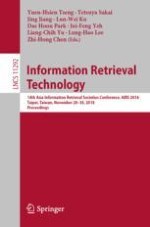2018 | Book
Information Retrieval Technology
14th Asia Information Retrieval Societies Conference, AIRS 2018, Taipei, Taiwan, November 28-30, 2018, Proceedings
Editors: Yuen-Hsien Tseng, Dr. Tetsuya Sakai, Jing Jiang, Lun-Wei Ku, Dae Hoon Park, Jui-Feng Yeh, Liang-Chih Yu, Lung-Hao Lee, Zhi-Hong Chen
Publisher: Springer International Publishing
Book Series : Lecture Notes in Computer Science
